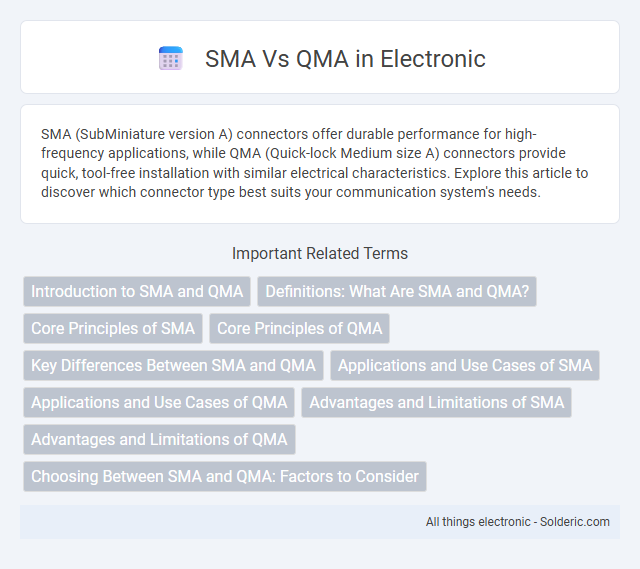SMA (SubMiniature version A) connectors offer durable performance for high-frequency applications, while QMA (Quick-lock Medium size A) connectors provide quick, tool-free installation with similar electrical characteristics. Explore this article to discover which connector type best suits your communication system's needs.
Comparison Table
| Feature | SMA Connector | QMA Connector |
|---|---|---|
| Type | Threaded RF coaxial connector | Quick-lock RF coaxial connector |
| Connection Mechanism | Threaded coupling (1/4-36 threads) | Snap-on quick-lock system |
| Frequency Range | Up to 18 GHz (often 12.4 GHz) | Up to 6 GHz |
| Impedance | 50 Ohms | 50 Ohms |
| Durability | 500+ mating cycles | Up to 500 mating cycles |
| Installation Speed | Slower, requires screwing | Faster, tool-less snap-on |
| Size | Small, compact (6.35 mm outer diameter) | Compact, slightly larger than SMA |
| Typical Use | High-frequency, precision test and measurement | RF applications requiring quick assembly |
Introduction to SMA and QMA
SMA (SubMiniature version A) and QMA (Quick Lock Miniature A) connectors are popular RF coaxial connectors used in high-frequency applications. SMA connectors feature threaded coupling for secure connections and operate effectively up to 18 GHz, while QMA connectors provide a quick-lock mechanism for faster mating and can handle frequencies up to 12.4 GHz. Both connectors are widely utilized in telecommunications, microwave systems, and wireless communication devices requiring reliable signal transmission.
Definitions: What Are SMA and QMA?
SMA (SubMiniature version A) and QMA (Quick-lock Miniature Adapter) are types of coaxial RF connectors commonly used in telecommunications and wireless applications. SMA connectors feature a threaded coupling mechanism for secure connections and are designed for frequencies up to 18 GHz, providing reliable signal integrity. QMA connectors, derived from SMA, offer a snap-on, quick-locking mechanism, enabling faster mating and demating while maintaining similar electrical performance and frequency ranges.
Core Principles of SMA
The core principles of Single-Multiple Access (SMA) emphasize simplicity and efficiency in communication by allowing only one device to transmit at a time, preventing signal collisions and ensuring clear data transfer. SMA relies on time division or token-based methods to regulate access, optimizing network performance in environments with limited traffic. Understanding SMA's structure helps you design systems that prioritize reliability over simultaneous multi-device communication, making it ideal for specific low-traffic or legacy applications.
Core Principles of QMA
QMA (Quadratic Mimicry Algorithm) centers on leveraging quadratic forms to enhance approximation accuracy in complex problem spaces, distinguishing itself from SMA (Simple Matching Algorithm) by its sophisticated approach to data representation. The core principles of QMA involve quadratic error minimization, adaptive weighting schemes, and iterative refinement to improve predictive precision. This quadratic framework enables QMA to capture nonlinear relationships more effectively, resulting in superior performance for multidimensional datasets compared to linear techniques like SMA.
Key Differences Between SMA and QMA
SMA (SubMiniature version A) connectors feature a threaded coupling mechanism, providing secure and reliable connections ideal for high-frequency applications up to 18 GHz. QMA (Quick Locking Miniature A) connectors utilize a push-pull quarter-turn coupling system, enabling faster mating and un-mating while maintaining performance up to 22 GHz. SMA connectors are preferred for applications demanding robust mechanical stability, whereas QMA connectors prioritize quick installation and frequent connection cycles without sacrificing signal integrity.
Applications and Use Cases of SMA
SMA connectors are widely used in RF and microwave applications due to their excellent performance up to 18 GHz, making them ideal for antenna connections, test equipment, and telecommunications. Their compact size and high durability suit precision instruments and wireless communication systems requiring reliable, low-loss connections. Your choice of SMA connectors ensures optimal signal integrity in environments demanding consistent performance and robust mechanical stability.
Applications and Use Cases of QMA
QMA connectors are widely used in wireless communication systems, including Wi-Fi, cellular base stations, and RFID devices, due to their quick connect-disconnect capability and robust performance in high-frequency applications. Unlike SMA connectors, QMA connectors excel in environments requiring frequent mating cycles and vibration resistance, making them ideal for military, aerospace, and automated test equipment. Their push-on coupling design facilitates efficient assembly and maintenance in compact electronic devices and instrumentation.
Advantages and Limitations of SMA
SMA connectors offer superior durability and consistent performance at high frequencies up to 18 GHz, making them ideal for precision RF applications. Their threaded coupling mechanism provides secure and stable connections, reducing signal loss and interference in demanding environments. However, SMA connectors typically feature a smaller size and higher cost compared to QMA connectors, which limits their ease of use and quick-connect capabilities in rapid deployment scenarios.
Advantages and Limitations of QMA
QMA connectors offer significant advantages such as easy push-pull locking mechanisms, which enable quick and secure connections ideal for high-frequency microwave applications up to 18 GHz. Their compact size and low VSWR make them suitable for modern RF designs where space and signal integrity are critical. However, QMA connectors may have lower mechanical strength compared to SMA connectors, making them less ideal for harsh environments or applications requiring robust durability.
Choosing Between SMA and QMA: Factors to Consider
When choosing between SMA and QMA connectors, consider factors such as size, installation ease, and performance frequency range. SMA connectors offer superior durability and higher power handling, making them ideal for applications requiring robust connections and frequencies up to 18 GHz. QMA connectors provide quick snap-on installation and are suitable for environments where frequent connection changes occur, supporting frequencies up to 6 GHz, so your choice depends on balancing convenience with technical requirements.
SMA vs QMA Infographic

 solderic.com
solderic.com